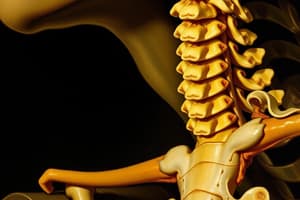Podcast
Questions and Answers
What is the percentage of non-diffusible calcium in serum?
What is the percentage of non-diffusible calcium in serum?
- 40%
- 45%
- 55%
- 4.5 mg% (correct)
What is the biologically active form of calcium?
What is the biologically active form of calcium?
- Diffusible calcium
- Ionized calcium (correct)
- Non-ionized calcium
- Protein-bound calcium
What is the primary site of action of calcitonin?
What is the primary site of action of calcitonin?
- Bone (correct)
- Kidneys
- Thyroid gland
- Parathyroid gland
How does calcitonin decrease serum calcium levels?
How does calcitonin decrease serum calcium levels?
What is the effect of calcitonin on the kidneys?
What is the effect of calcitonin on the kidneys?
What is the effect of calcitonin on osteoclasts?
What is the effect of calcitonin on osteoclasts?
Flashcards are hidden until you start studying
Study Notes
Normal Serum Calcium Level
- Normal serum calcium level ranges from 9-11 mg%
- Represented by two forms: endocrine and non-endocrine
Endocrine Forms of Calcium
- 4.5mg% non-diffusible (protein bound)
- 5.5% diffusible, which is further divided into:
- 0.5mg% non-ionized
- 5mg% ionized (biologically active)
Calcium Homeostasis
- Controlled by three main regulators:
- Calcitonin
- Parathormone hormone (PTH)
- Vitamin D
Calcitonin
- A polypeptide hormone
- Secreted by the parafollicular C (clear) cells of the thyroid gland
- A calcium-lowering hormone
Mechanism of Action of Calcitonin
- Binds with surface membrane receptors
- Activates adenyl cyclase enzyme
- Formation of cAMP from ATP
- Activates a cascade of enzyme system mediating the action of the hormone
Functions of Calcitonin
- Main action: decreases serum calcium level when it's increased above normal value
- Decreases serum calcium level by:
- Inhibiting bone resorption by osteoclasts
- Stimulating osteoblasts to deposit calcium and phosphate in bone
- Decreasing the formation of new osteoclasts (chronic effect)
- Increasing the excretion of Ca++ and PO4 in the kidneys (weak mechanism)
Studying That Suits You
Use AI to generate personalized quizzes and flashcards to suit your learning preferences.




